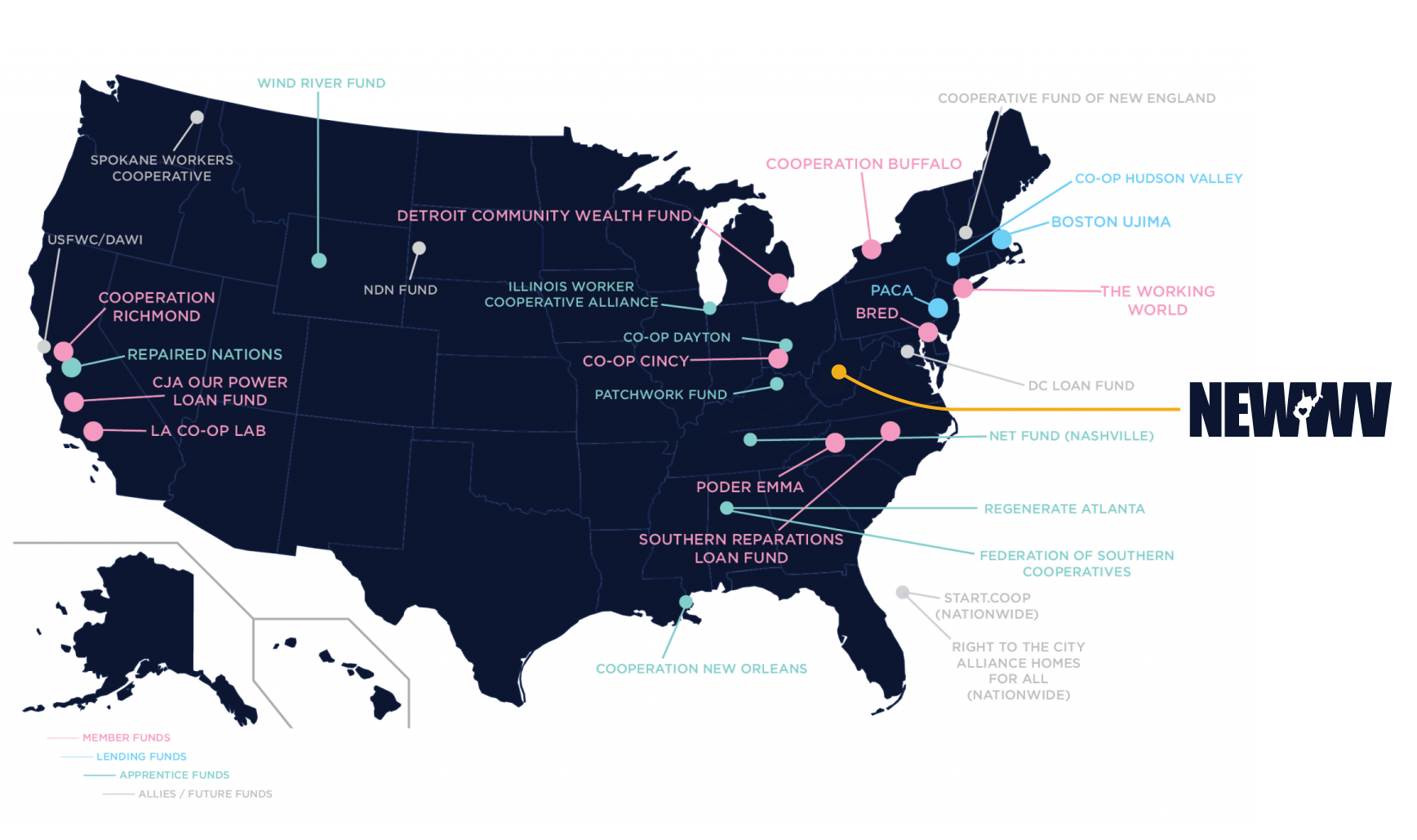new economy works West Virginia
Our mission is to support, and finance self-governing cooperative businesses in communities that have been economically extracted.


NEW WV is part of a more extensive regional and national network that helps supply resources and guidance to NEW WV. As a representative and local ambassador of Seed Commons and Southern Reparations Loan Funds Network, we work according to the five principles that guide Seed Commons and the SRLF Networks. This network of organizations assists us in carrying out our mission of building cooperative enterprises in marginalized communities.

These are businesses that operate under the 7 Cooperative Principles
Cooperatives are voluntary organizations, open to all persons able to use their services and willing to accept the responsibilities of membership, without gender, social, racial, political or religious discrimination.
Cooperatives are democratic organizations controlled by their members, who actively participate in setting their policies and making decisions. Men and women serving as elected representatives are accountable to the membership. In primary cooperatives members have equal voting rights (one member, one vote) and cooperatives at other levels are also organized in a democratic manner.
Members contribute equitably to, and democratically control, the capital of their cooperative. At least part of that capital is usually the common property of the cooperative. Members usually receive limited compensation, if any, on capital subscribed as a condition of membership. Members allocate surpluses for any or all of the following purposes: developing their cooperative, possibly by setting up reserves, part of which at least would be indivisible; benefiting members in proportion to their transactions with the cooperative; and supporting other activities approved by the membership.
Cooperatives are autonomous, self-help organizations controlled by their members. If they enter into agreements with other organizations, including governments, or raise capital from external sources, they do so on terms that ensure democratic control by their members and maintain their cooperative autonomy.
Cooperatives provide education and training for their members, elected representatives, managers, and employees so they can contribute effectively to the development of their co-operatives. They inform the general public – particularly young people and opinion leaders – about the nature and benefits of co-operation.
Cooperatives serve their members most effectively and strengthen the cooperative movement by working together through local, national, regional and international structures.
Cooperatives work for the sustainable development of their communities through policies approved by their members.
The most basic definition of a cooperative is where a group of people come together, make decisions in a one-person one-vote manner, and who engage in an enterprise together where the benefits and responsibilities are shared between the group.
It takes a minimum of three people to form a cooperative, and some cooperatives can have hundreds or even thousands of members.
Cooperatives are just like any other traditional business in that the main priority is to earn a profit from the enterprise. But unlike traditional businesses, the profits go to the people who do the daily work to make the business profitable. This helps to build individual, generational, and community wealth instead of the profits going to enrich already wealthy investors.
In addition, the members/workers are the ones who make the decisions about the business. This means that cooperatives usually make more ethical, empathetic, and humane decisions. Unlike a corporation, shareholder profit is NOT the main goal. If you follow business news, there are stories almost everyday about a company shedding workers so that shareholders can earn more profits. This would most likely not happen in a cooperative because the “shareholders” in the company would be firing themselves.
There are many more examples of how cooperatives can result in better decision making. A business that is in a community, and where those community members are the worker-owners, will rarely uproot itself and leave the community. Cooperatives usually have more environmentally responsible policies because their worker-owners live in the community. And most importantly, the profits aren’t extracted and sent to some far-off investor. They are instead kept within the community in a way that can help uplift people.
There are a few different forms of cooperatives, you can click on the following links to get more information about the following cooperative models.
Adequate housing is a basic need, but the supply of housing is a wholly profit driven business. Most low-wage workers pay more than 30% of their income toward a rental unit before any utilities are even paid. Often these units are shabby and very energy inefficient, causing higher energy bills than a nicer residence. A lot of money goes to landlords and utility companies, and none to building individual wealth that can be passed to the next generation.
Housing cooperatives can help alleviate these economic pressures. They can also start to provide ownership of a home or apartment but with a support system to help maintain the housing unit. They can also help stave off the forces of gentrification, as they anchor low-income people in the places they live.
Housing cooperatives work like any other cooperative in that they are based on a one-member one-vote. This is where each member of the cooperative votes on decisions that affect the cooperative. Members have shares in the larger company, and if the real estate held by the company appreciates in value, the member share also appreciates, further helping to build individual, generational, and community wealth.
Any sort of building can be part of a housing cooperative, from a single story home to a skyscraper, a trailer, or a large apartment building. These sort of cooperatives come in all shapes and sizes, the main thing is that the people who live or work in the buildings make decisions about how the property is maintained and operated.
Here are some resources for a more in depth look at housing cooperatives:
National Association of Housing Cooperatives
This kind of cooperatives have been widely used over the last century here in the
US, and are found most often in the agricultural sector. There are many reasons why small- to midsize farmers come together to form a cooperative.
Producer cooperatives can be based around the shared purchase and use of expensive farm machinery. Or they can form around the need to aggregate their produce into large bulk amounts to reach large markets. They can also come together under a shared brand for a cooperative marketing strategy. Sometimes a producer cooperative can combine all of these elements to best share the costs and risks of the agricultural sector.
Because this form of cooperative has seen a great deal of use among farmers, some large-scale examples have been built over the years. Some companies that are household names are producer cooperatives, including Welch’s, Florida’s Natural Growers, and Land O’ Lakes.
A couple of examples of non-agricultural producer cooperatives are Ace hardware and the Associated Press.
This model of cooperatives are the most transformative in that the workers in the business own and control the company. This means that they vote according to democratic decision making principles on issues such as where the profit goes, how the business is managed, and how economic storms are weathered.
This can have a profound effect on the worker and their surrounding community. Because there are no traditional type of investors, and the decisions are made by the workers, most often the profits of the business are dispersed among the workers. This helps the workers build wealth among themselves, rather than already wealthy investors.
One of the largest examples of a worker-cooperative is the Mondragon Corporation, which is a federation of hundreds of worker-owned cooperatives and is the seventh largest company in Spain. It has been in operation since the 1950s, and the cooperatives within it produce everything from industrial components, household items like washers and dryers, bicycles, and it even has its own bank. During the 2008-2009 financial crisis, it was able to shift workers in troubled industries to more profitable ones rather than laying them off like many traditional companies did.
In the US, the worker cooperative movement is much younger, but some notable examples exist. One of these is New Era Windows based in Chicago is a worker-owned cooperative formed in 2012 when a group of workers, who were laid-off when the business owner decided to close the factory, bought the business and reopened it as a cooperative. This was one of the first projects in the Seed Commons network of which NEW WV is part. It is an example of the economic power that low-income Black, immigrant, and white workers can have when they take control of their workplace by forming a cooperative.
Worker cooperatives can operate in a wide variety of industries, including childcare, bakeries, restaurants, information technology, construction, and solar installation to name a few. Pretty much any company that can be ran in the traditional way can be a cooperative!
When most of us think about business financing, we mostly think of going to a banker and asking for a loan. The banker then tells you yes or no (usually no if you are Black, or low-income, or if you don’t have great credit). If the banker says yes, you’ll get the loan and you’ll probably never talk to that banker again.
Because it doesn’t matter if you have a great business, or even if your business fails, because what really matters to the bank is if you have collateral you can put up, like your house. The banker wins either way — if you pay back the loan then great. If not…they can just take your collateral.
The way NEW WV lends to cooperative businesses is very different, in fact we consider how we lend to be a whole new way to do financing. First, we do not require collateral or even your credit score. The three things that we look for are 1) a solid business plan that shows a sustainable business model, 2) a group of people who can work together in a cooperative, and that 3) these people can execute the business plan and build a successful business.
Our lending process is also different in that your loan officer will work with you to develop your business plan and connect you with resources to build a strong cooperative culture. Even after the loan is issued, your loan officer will be working hand-in-hand with you to make the best decisions and to provide any needed support in the first crucial months of your business.
Our whole mission is to get business financing into the hands of people who a traditional banker wouldn’t give the time of day. Our process involves a whole lot more work on your part, but at the end you will have a strong business that will last for years and that can help build community and generational wealth.
And we only get paid back if your business is profitable, we do not extract any of your personal property to pay back loans, This is why a solid business plan is so important. Because once your business is profitable and the loan is paid back, then we can help another group of people start another cooperative business.